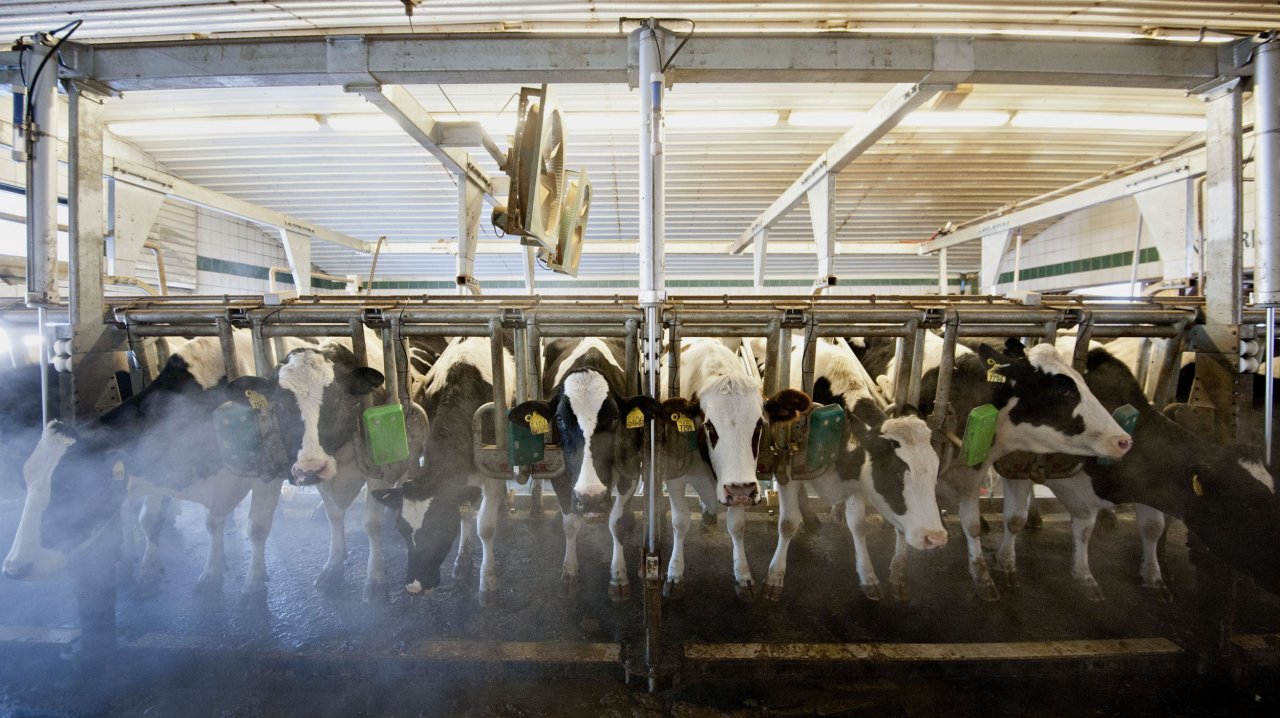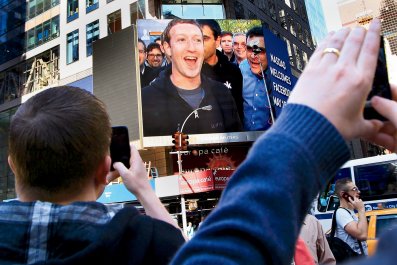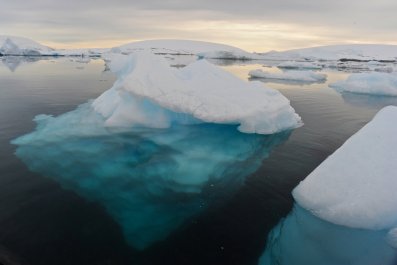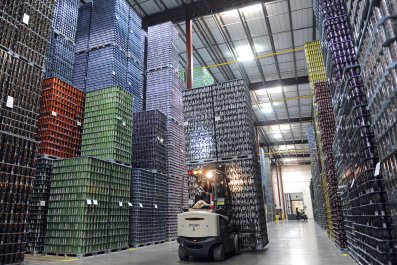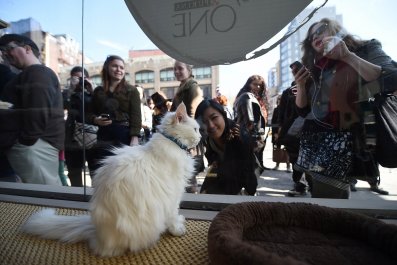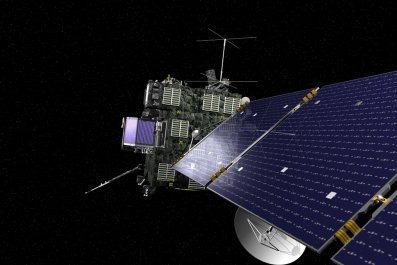Karen Beauchemin spends every day in her lab at Agriculture and Agri-Food Canada (AAFC) in Alberta, Canada, working on cow feed. Boring, you say? Far from it. Beauchemin is part of an international task force of scientists working on a multimillion-dollar project for Dutch life-sciences giant DSM that may be the world's best bet to avert climate disaster.
It's all about cows. Our favorite milk producer belongs to the animal group called ruminants, which also includes other livestock such as sheep and goats. Ruminants are having serious effects on global climate change. To put it bluntly, these beasts are emitting tons of methane through their burps and farts. (And those burps actually account for around 95 percent of animal methane production.)
Ruminants all have lots of microscopic organisms living in their digestive tract that help them digest cellulose—a component of the cell wall of green plants. It's a huge boon for these animals, giving them the ability to get energy from pretty much any plant that grows on Earth. Cows can't digest grass without these microorganisms. The catch is that when the organisms digest the cellulose, they create carbon dioxide and methane gas, which the host animal has to get rid of. All ruminants excrete methane, but cows are by far the most prolific emitters.
"A cow emits as much carbon dioxide-equivalent as a family car," says Rasmus Helveg Petersen, minister of climate, energy and building in Denmark.
Manure adds further greenhouse gas emissions, as does the deforestation required to create the grazing space for more cattle. "Agriculture and related land use change activities account for 20 to 24 percent of all greenhouse gas emissions," explains Francesco Tubiello, of the Food and Agriculture Organization of the United Nations (FAO). "That makes it second only to the energy sector."
For some time, think tanks and environmental groups have been promoting Meatless Mondays, which would reduce emissions from cows simply because we'd be eating fewer of them, and therefore raising fewer of them. Governments have imposed stricter rules on manure storage. Even so, global production of both beef and dairy are on the rise. The world's population is increasing, and in developing countries many are moving up into the middle class and starting to adopt Western-style eating habits. Between 1980 and 2005, per capita milk consumption in developing countries almost doubled, and meat consumption more than tripled. In China, where the population is 1.351 billion strong, the average citizen ate about 8.8 pounds of beef a year in 2010; in 2020 the figure is expected to reach 12 pounds, according to government statistics.
In Western countries, any politician knows that asking voters to stop drinking milk and eating beef would risk not just ridicule but fury—particularly in the U.S. But at the same time, no area of climate change is as untapped, or as intriguing, as livestock flatulence. According to FAO statistics, methane released by cows accounts for about 4 percent of the globe's total greenhouse gas emissions. Consider this: We tend to point fingers at our reliance on gas-guzzling cars, but FAO estimates peg transportation (including cars but also buses, planes, ships and more) as responsible for 14 percent of all greenhouse gas emissions—or just about three times as much as cow flatulence .
All of which is why Beauchemin and her fellow DSM-funded scientists at the AAFC are working on a greenhouse gas-slashing compound that cows can eat with their daily feed.
This isn't the first time scientists have explored ways to change a cow's diet. French company Valorex has created a menu featuring flaxseed and alfalfa, which it says reduces methane emissions by one-fifth. Others suggest more grains or soybeans, which would have a similar effect. According to an article in the Journal of Dairy Science, however, such diet changes reduce cows' methane emissions by only up to 15 percent. And as Carlos Gonzalez Fischer, at the animal welfare group Compassion in World Farming, points out, feeding grains (instead of plain old grass and hay) to animals is unsustainable.
"Cows are pretty inefficient in transforming feed into food. For every 100 calories a cow eats, we only get 40 back as milk and just three as beef," he says. There's another complication: The additional land needed for grain feed would result in even more emissions.
Enter DSM, a former state coal mining company that has undergone an unlikely evolution into a global material and life-sciences conglomerate with operations on five continents and annual revenues of 9.1 billion euros ($12.43 billion). The company directly employs a number of scientists who work alongside DSM-funded academic researchers such as Beauchemin to solve the cow dilemma. And they think they've done it.
The team now has a powder that cows can eat with their daily feed. "It interferes with the animal's biological mechanisms," Beauchemin says. "That stops the microorganisms in the animal's stomach from doing what they're doing."
"In trials we've managed to reduce methane emissions by up to 60 percent," says Petra Simic, a biochemist who directs DSM's cow-methane efforts. "We have solid proof of concept that our compound does what it's supposed to do. What we're working on now is figuring out the best way of mixing it into the cow's feed."
They are also testing the feed's safety. Without a guarantee that it's completely safe for their animals, virtually no farmer would agree to use the additive. Perhaps more important, the scientists are working to make sure the milk and beef will taste the same as the regular variety—if they don't, it will never sell.
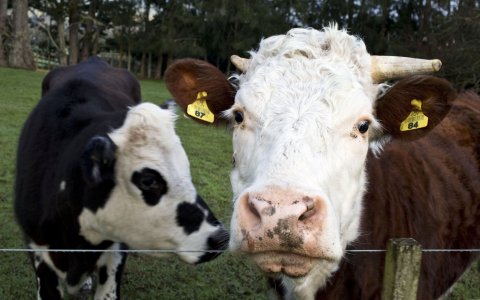
In the future, farmers may not even have to add a pill or powder to Daisy's daily feed. Several years ago, researchers in Australia, which has 28.5 million cattle and ranks third among the world's beef exporters, developed a crude version of a vaccine that also lowers ruminants' methane emissions, by permanently fighting off the methane-producing microbes inside the cows' guts. A team in New Zealand (which has twice as many cows as inhabitants), working at the government-owned AgResearch institute, has taken that work to the next level. It has completed the laboratory tests on a new form of the vaccine and has started testing it on animals.
"We've successfully demonstrated in the laboratory that sheep can raise antibodies that will reduce methane emissions," reports Harry Clark, director of the government-funded New Zealand Agricultural Greenhouse Gas Research Centre, which is co-funding the work in conjunction with a consortium of private sector investors. "That's a very big step." In the lab, the vaccine reduced methane emissions by 30 percent.
The scientists are testing their prototype vaccines on both sheep and cows, but finding the right mix of antigens is a maddeningly complex task. That's because blocking one methane-producing organism isn't enough: One vaccine has to be able suppress the activities of the diverse groups of methane-producing organisms in an animal's stomach.
Still, having created a lab vaccine is a major breakthrough, and Clark is cautiously optimistic that within two years the AgResearch team will be able to demonstrate a vaccine that can work in animals out on the farm. "Vaccines are very easy to use, and production costs are generally low," he notes. "Plus, a vaccine even offers the prospect of a once-in-a-lifetime intervention, which makes it suitable for use in situations where animals are not seen and handled on a frequent basis."
Most agree that slashing livestock flatulence would be a significant tool in the fight against global warming—maybe not as powerful as ending reliance on fossil fuels, but perhaps a realistic way to get global change. "If the powder and vaccines work, it will be very significant," says Johan Kuylenstierna, policy director of the Stockholm Environment Institute. "The most important issue in the long term is cutting CO2, but methane is a very significant greenhouse gas that we also have to address."
It should be easy to get consumers on board. As far as DSM CEO Feike Sijbesma is concerned, good marketing may be his company's best ally. He refers to the project as "Clean Cow" and envisions a system where farmers who cut their cows' direct emissions by, say, 50 percent or more can label their beef and dairy products "Clean Cow."
Clean Cow is a clever label indeed: After all, which consumer would choose the alternative? Imagine potential conversations in households around the world: "Did you get milk today?" "Yes, but I could only find Dirty Cow." "Yuck, I'm not drinking that."
Petersen compares the concept to organic food, which grew from an $11 billion market in the U.S. in 2004 to a $28 billion one by 2012. "This shows that consumers can help drive change," he says. "Such a development might be possible for Clean Cow as well."
Of course, if and when DSM's formula is approved by regulators, the labeling will be decisive. "Today people are so used to organic food that if you add anything to the animal, it gets really negative attention," says Alyce Machado Luis, a dairy farmer in California's Central Valley. "If you used a powder that cuts cows' methane emissions and the milk package had to say that on the label, people wouldn't buy it. But if the package said 'clean milk,' they would."
One group of stakeholders will still need convincing. Since they're not taxed on their cows' flatulence, farmers have little reason to cut emissions, especially if it involves an expense or makes their milk and beef less attractive. "Why should we mess with our cows in order to fix climate change?" asks Martin Moraeus, a farmer in the Swedish province of Dalarna.
The farmers might be driven by the market. Just as consumer demand has created more organic farms, it might create more clean cows. In addition, Simic, Beauchemin and their colleagues may have another solution: They are investigating whether their formula also makes the cow more productive. "Producing all that methane requires a lot of energy inside the cow," Beauchemin explains. "Reducing the methane should free up more energy within the cow for growth and milk productions." If that's the case, predicts Beauchemin, those initially reluctant to use the powder will embrace it.
That links to another methane fix: Breeding cows to make them more productive. Planned cross-breeding could increase cows' productivity, notes the FAO. And because we'd get more milk or meat out of every animal, we'd need fewer cows and would thus be able to reduce greenhouse gas emissions.
But even if the world collectively decided to breed more productive cows, doing so would take years. And with the vaccines' effectiveness unclear, DSM's compound seems the most likely cow fix.
Fischer, the biologist and animal activist, worries that clean cow dreams will lull us into a false sense of security: "The danger is that we'll see 'clean cows' as a license to produce even more beef and dairy." And the risk is that it won't stop there. For Clean Cow, vaccines or any other flatulence-fixing product to help us minimize climate change, it has to supplement other CO2 cuts, not be used as an alternative. But Clean Cow may make us feel so virtuous that we use it as absolution for an annual holiday flight, or two or three. And for CO2-spouting daily drives to the supermarket to buy clean milk.
SEE THE LISTS: Top 10 Green Companies in the World | Top 10 Green Companies in the U.S | Full World Rankings | Full U.S. Rankings
Our Green Rankings Section



